5 Lead Scoring Examples + Tools To Get You Started!
5 Lead Scoring Examples + Tools To Get You Started!
5 Lead Scoring Examples + Tools To Get You Started!
Explore five lead-scoring examples and some tips and tricks to help you become a lead-scoring master.
Explore five lead-scoring examples and some tips and tricks to help you become a lead-scoring master.
Explore five lead-scoring examples and some tips and tricks to help you become a lead-scoring master.



Looking for some lead scoring examples?
You’ve come to the right place.
Multiple lead scoring methods can help you identify high-intent leads worth chasing.
To help you determine which option suits you best, we’ll dive into five great examples of lead scoring models.
We’ll also introduce you to an awesome tool that can help you quickly build a kick-ass product-qualified pipeline!
Buckle up, and let’s go!

Five Lead Scoring Examples You Should Have In Your Tool Belt
Here are five lead scoring example tips, best practices for lead scoring, along with tools to help you ace them:
1. Manual Lead Scoring
This lead scoring model is the granddaddy of all methods.
No fancy lead scoring software or complex algorithms.
All you need is a good ol’ spreadsheet.
The first step of manual lead scoring is deciding on a points system for prospective leads.
Ask yourself:
What is the buyer persona for your best prospect?
What behavioral data will you be scoring on?
How many points will you assign each prospect for an action?
Once you’ve answered these questions, you can start calculating your leads score.
Here’s an example of point value for a manual scoring system to help build your own:
+3 points for liking a social post
+5 points for opening an email
+10 points for filling out an interest form
-10 points for unsubscribing from an email list
(Yes, negative scoring is indeed a part of lead grading!)
Tally all these points in a spreadsheet for each lead, and you’re good to go.
Sound good?
There’s a catch.
With manual lead scoring, nailing down a ‘good lead’ with a high score for your sales team will require them to dedicate lots of time and effort just to tweak and update the system — using Excel. 🙅
We’re not kitten 😉.

The solution?
Relying on methods that leverage marketing automation and artificial intelligence (AI) to help you lead score with ease.
Psst… Toplyne is a headless AI tool that uses automation and AI to help you build a high-intent pipeline and increase win rates!
If you value your time, here are a few other scoring system options that might be less cat-astrophic for your digital marketing activities and lead qualification!
2. Email Lead Scoring
This is a great lead scoring model for companies prioritizing their email marketing efforts.
For this scoring model, point value is allocated based on email open and click-through rates, and you deduct points for lack of interactions or unsubscribing.
This ensures that the next batch of email recipients are the cream of the crop!
Here’s an example of how you can measure point value for an email lead score and the behavioral data involved:
+10 points for an email open
+25 points for an email click-through
-10 for no opens on three consecutive emails
Email-based lead scoring software such as Mailchimp and ActiveCampaign offer quality options for companies. They leverage user grouping analysis to determine the value of a lead.
But…
This model has its drawbacks, one of which is having scoring data from only one source to create a leads score.
What if your high-intent leads think email marketing is outdated and prefers to spend their time scrolling the socials? 📱
And what if the same ‘good lead’ that receives a higher score on one platform interacts differently with content on other platforms?
For example, they might sooner ‘like’ a social post than open that unread email sitting amongst hundreds of others in their crowded inbox.
This could lead you to disqualify tons of high-potential leads, wasting marketing efforts!

It’s probably a good idea to broaden your focus and score leads on more than just email marketing interactions.
Which brings us to…
3. Social Media Lead Scoring
A social media scoring model offers capabilities that the email lead scoring model doesn’t, e.g. including multiple social channels to calculate the value of your overall points.
Great to help your marketing team target those social scrollers!
When determining your social media lead scoring criteria, here's a point value example that could help kickstart the process, determine a qualified lead and assign a lead score:
+5 points for a post like
+10 points for a post share
+15 points for four or more consecutive post likes
Sounds like a lot of manual work?
Not to worry — you don’t have to carry the weight of a social media lead scoring model alone!

You can use tools like ZohoCRM and HubSpot with built-in social media-focused options to assist with marketing automation and uncover which qualified lead your marketing and sales team should pursue!
Generating a HubSpot score or Zoho score can provide insight into lead qualification.
But like email scoring, this method has its limitations.
By solely focusing on social media interactions, you won’t get the full picture of who your leads are, limiting you from maximizing lead scoring best practices.
You may know who to target based on their interactions with your social pages, but identifying your best prospect will take more than evaluating a simple ‘like’ or ‘share’ on social media.
While chasing those social media lovers can be great (to an extent), you’ve yet to explore a whole world of potential leads.

Our next lead scoring example makes things a little more personal…
4. Behavioral and Demographic Lead Scoring
This lead scoring system involves some in-depth analysis. 🔍
In other words, your sales team will get to know your leads a little better using this scoring model...

With demographic and behavioral data, you can base your lead scoring criteria on tracking product usage as a data point and categorizing leads by their buyer persona, helping you decipher their likelihood to purchase.
While the individual’s lead scoring attributes still play a role, you should focus more on product interactions for this scoring method.
What makes them tick? 🕰️
What in-product actions indicate the likelihood of converting to a sale?
When you understand ideal lead scoring attributes, you can create a pipeline of product-qualified leads and work on targeting and driving conversions for that entire group.
Some data point categories used to determine a lead score for this style of scoring are:
Implicit scoring via specific product or in-app actions that indicate buyer intent, such as creating a team account, clicking on premium features, regular logins, or looking at the premium pricing page.
Explicit scoring that tells you about a person’s age, income, or role at the current company — especially useful for B2B lead scoring.
A variety of lead profiles can enhance lead grading and make mastering lead scoring best practices a piece of cake. 🍰
The problem?
Not everyone is an open book, and it can be challenging to get your hands on demographic info to fill in those lead grading gaps.
Most of the time, your marketing and sales team can only gather demographic data from forms your leads fill out.
This isn’t ideal because:
The data in these forms may be inaccurate as leads might not want to divulge personal information.
Your leads might not want to deal with the hassle of filling out detailed forms without incentive.
This may make life a little trickier for your sales rep.
But fret not — this next method is the literal opposite of a hassle (as is the lead scoring tool accompanying it)!
5. Predictive Lead Scoring
Finally, you’ve arrived at the right place.

As a whole, predictive scoring offers more than any other scoring system out there.
It combines the elements of all the best practices and types of models above and incorporates machine learning technology. The range of lead generation capabilities offered by predictive scoring is simply unmatched.
Through marketing automation and artificial intelligence (AI), a predictive lead scoring tool analyzes thousands of data points for predictive scoring. These include:
Product usage signals
Email interactions
Social platform interactions
Do you know what that means?
Automation takes on the bulk of your lead scoring process, allowing your marketing team and sales team to focus on developing the best conversion strategy possible. 🙌
The bonus?
Predictive lead scoring models get smarter over time, so there’s no need to spend hours updating them (unlike manual lead scoring).

Some predictive lead scoring tools you may have heard of are HubSpot and Salesforce. Their lead generation capabilities include:
Scoresheets for different audiences or leads
Running multiple lead scoring models at the same time
Incorporating automatic negative scoring into lead scoring attributes
But what if we told you there’s a tool that leverages predictive lead scoring (and more) to help you build a high-functioning pipeline of product qualified leads?
Go Above and Beyond Predictive Lead Scoring with Toplyne
Toplyne is a unique headless sales AI tool that enables sales teams to effectively streamline their pipeline to engage, retain, and monetize users.
It uses in-app usage data for lead qualification to deliver a product-qualified pipeline to your existing CRM (like Salesforce or HubSpot). With these many PQLs at your disposal, your sales rep will thank you each time they set new win rate records. 🏆
What’s more?
Once converted, a user will keep delivering value for your product as Toplyne helps you identify better cross-sell and up-sell opportunities, skyrocketing your NRR (net revenue retention)!
Here’s how Toplyne can help you score:
Toplyne lets you create monetization playbooks to help you spot:
Conversion opportunities: Filter leads by their likelihood to convert to a sale.
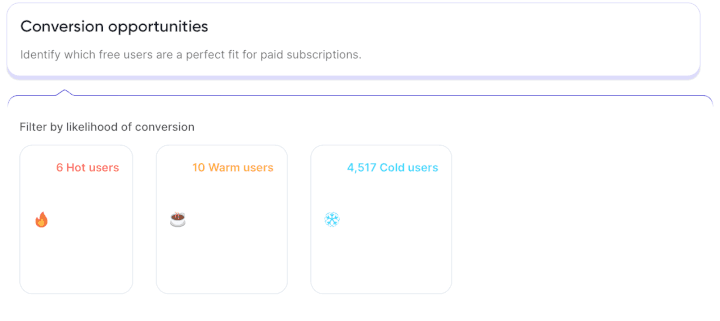
Expansion opportunities: Filter leads by most likely to expand their accounts.
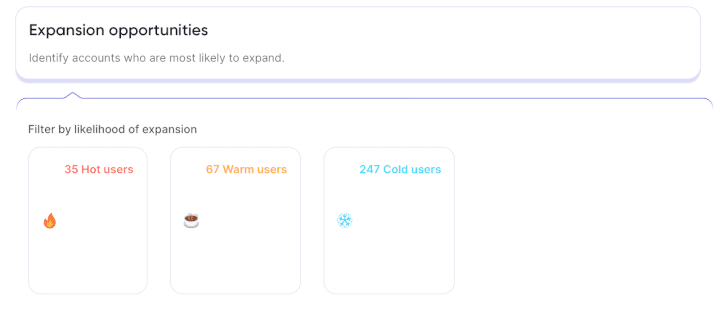
First, you’ll need to decide who you want to target:
Users: individual users
Accounts: a group of users with an organization
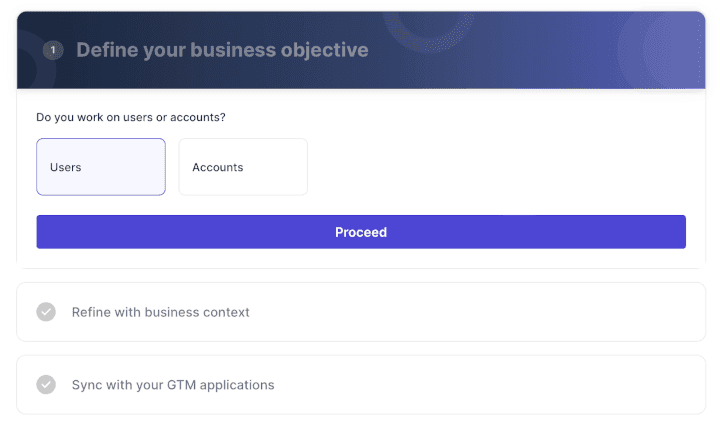
Next, you’ll be able to select your business goal:
Conversion opportunities: Filter leads by determining which are a perfect fit to convert to a paid plan sale.
Expansion opportunities: Filter by accounts most likely to expand.
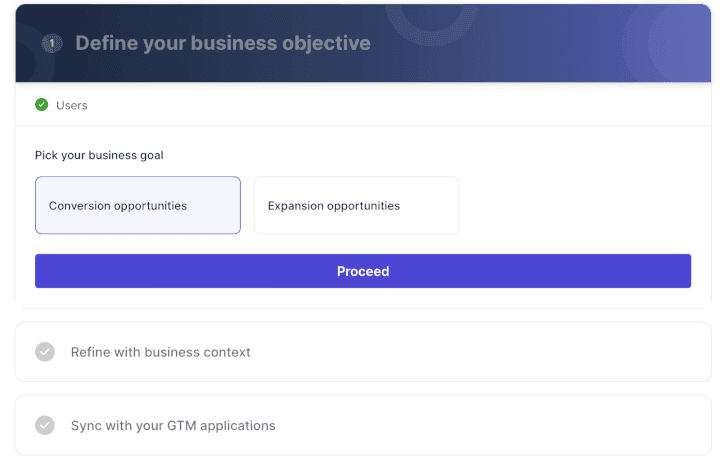
Then, select the lead stage you want to focus on:
All users: All leads included
Hot users: A qualified lead who is bordering on making a purchase
Warm users: Leads who have shown some interest in your product
Cold users: Leads who show no interest in your business or product
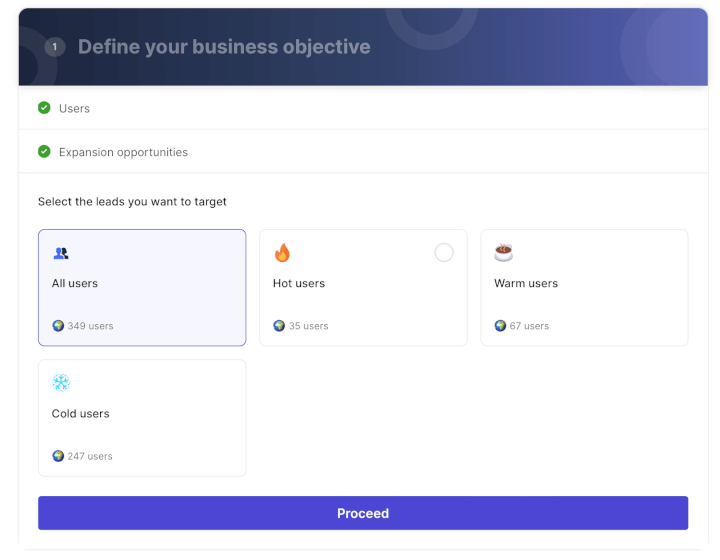
You can also segment your leads according to attributes and actions:

You even have the option to narrow it down further by looking at sales capacity, percentage, or a custom filter.
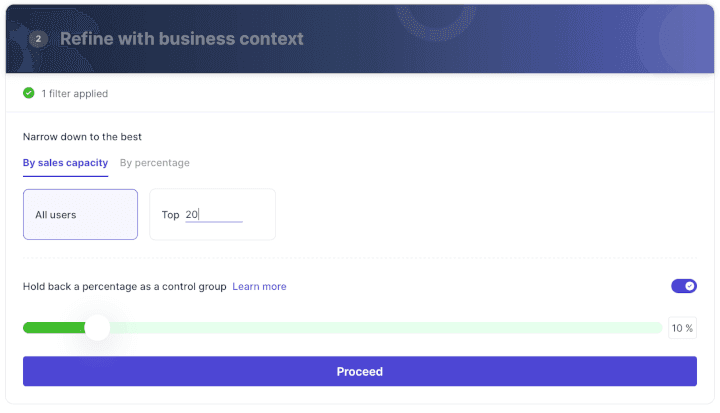
Lastly, sync your product-qualifed leads with the go-to-market apps of your choice, including Salesforce, Customer.io, HubSpot, and more! This way, your sales team can still rely on their existing tech stack alongside Toplyne, which slots in seamlessly.
Create an Exemplar Lead Scoring System with Toplyne!
You now have all the knowledge and tools you need to make an educated choice for your organization's lead scoring system. 🥳
Sure, other lead scoring models on this list can help you achieve your goals. But Toplyne is an all-in-one tool you can use alongside your existing tech stack to spot leads with a higher score and target them with the correct in-app nudges — within seconds!
So, why wait?
Sign up for a free trial of Toplyne today to find your most suitable leads and get your organization scoring! 😉
Looking for some lead scoring examples?
You’ve come to the right place.
Multiple lead scoring methods can help you identify high-intent leads worth chasing.
To help you determine which option suits you best, we’ll dive into five great examples of lead scoring models.
We’ll also introduce you to an awesome tool that can help you quickly build a kick-ass product-qualified pipeline!
Buckle up, and let’s go!

Five Lead Scoring Examples You Should Have In Your Tool Belt
Here are five lead scoring example tips, best practices for lead scoring, along with tools to help you ace them:
1. Manual Lead Scoring
This lead scoring model is the granddaddy of all methods.
No fancy lead scoring software or complex algorithms.
All you need is a good ol’ spreadsheet.
The first step of manual lead scoring is deciding on a points system for prospective leads.
Ask yourself:
What is the buyer persona for your best prospect?
What behavioral data will you be scoring on?
How many points will you assign each prospect for an action?
Once you’ve answered these questions, you can start calculating your leads score.
Here’s an example of point value for a manual scoring system to help build your own:
+3 points for liking a social post
+5 points for opening an email
+10 points for filling out an interest form
-10 points for unsubscribing from an email list
(Yes, negative scoring is indeed a part of lead grading!)
Tally all these points in a spreadsheet for each lead, and you’re good to go.
Sound good?
There’s a catch.
With manual lead scoring, nailing down a ‘good lead’ with a high score for your sales team will require them to dedicate lots of time and effort just to tweak and update the system — using Excel. 🙅
We’re not kitten 😉.

The solution?
Relying on methods that leverage marketing automation and artificial intelligence (AI) to help you lead score with ease.
Psst… Toplyne is a headless AI tool that uses automation and AI to help you build a high-intent pipeline and increase win rates!
If you value your time, here are a few other scoring system options that might be less cat-astrophic for your digital marketing activities and lead qualification!
2. Email Lead Scoring
This is a great lead scoring model for companies prioritizing their email marketing efforts.
For this scoring model, point value is allocated based on email open and click-through rates, and you deduct points for lack of interactions or unsubscribing.
This ensures that the next batch of email recipients are the cream of the crop!
Here’s an example of how you can measure point value for an email lead score and the behavioral data involved:
+10 points for an email open
+25 points for an email click-through
-10 for no opens on three consecutive emails
Email-based lead scoring software such as Mailchimp and ActiveCampaign offer quality options for companies. They leverage user grouping analysis to determine the value of a lead.
But…
This model has its drawbacks, one of which is having scoring data from only one source to create a leads score.
What if your high-intent leads think email marketing is outdated and prefers to spend their time scrolling the socials? 📱
And what if the same ‘good lead’ that receives a higher score on one platform interacts differently with content on other platforms?
For example, they might sooner ‘like’ a social post than open that unread email sitting amongst hundreds of others in their crowded inbox.
This could lead you to disqualify tons of high-potential leads, wasting marketing efforts!

It’s probably a good idea to broaden your focus and score leads on more than just email marketing interactions.
Which brings us to…
3. Social Media Lead Scoring
A social media scoring model offers capabilities that the email lead scoring model doesn’t, e.g. including multiple social channels to calculate the value of your overall points.
Great to help your marketing team target those social scrollers!
When determining your social media lead scoring criteria, here's a point value example that could help kickstart the process, determine a qualified lead and assign a lead score:
+5 points for a post like
+10 points for a post share
+15 points for four or more consecutive post likes
Sounds like a lot of manual work?
Not to worry — you don’t have to carry the weight of a social media lead scoring model alone!

You can use tools like ZohoCRM and HubSpot with built-in social media-focused options to assist with marketing automation and uncover which qualified lead your marketing and sales team should pursue!
Generating a HubSpot score or Zoho score can provide insight into lead qualification.
But like email scoring, this method has its limitations.
By solely focusing on social media interactions, you won’t get the full picture of who your leads are, limiting you from maximizing lead scoring best practices.
You may know who to target based on their interactions with your social pages, but identifying your best prospect will take more than evaluating a simple ‘like’ or ‘share’ on social media.
While chasing those social media lovers can be great (to an extent), you’ve yet to explore a whole world of potential leads.

Our next lead scoring example makes things a little more personal…
4. Behavioral and Demographic Lead Scoring
This lead scoring system involves some in-depth analysis. 🔍
In other words, your sales team will get to know your leads a little better using this scoring model...

With demographic and behavioral data, you can base your lead scoring criteria on tracking product usage as a data point and categorizing leads by their buyer persona, helping you decipher their likelihood to purchase.
While the individual’s lead scoring attributes still play a role, you should focus more on product interactions for this scoring method.
What makes them tick? 🕰️
What in-product actions indicate the likelihood of converting to a sale?
When you understand ideal lead scoring attributes, you can create a pipeline of product-qualified leads and work on targeting and driving conversions for that entire group.
Some data point categories used to determine a lead score for this style of scoring are:
Implicit scoring via specific product or in-app actions that indicate buyer intent, such as creating a team account, clicking on premium features, regular logins, or looking at the premium pricing page.
Explicit scoring that tells you about a person’s age, income, or role at the current company — especially useful for B2B lead scoring.
A variety of lead profiles can enhance lead grading and make mastering lead scoring best practices a piece of cake. 🍰
The problem?
Not everyone is an open book, and it can be challenging to get your hands on demographic info to fill in those lead grading gaps.
Most of the time, your marketing and sales team can only gather demographic data from forms your leads fill out.
This isn’t ideal because:
The data in these forms may be inaccurate as leads might not want to divulge personal information.
Your leads might not want to deal with the hassle of filling out detailed forms without incentive.
This may make life a little trickier for your sales rep.
But fret not — this next method is the literal opposite of a hassle (as is the lead scoring tool accompanying it)!
5. Predictive Lead Scoring
Finally, you’ve arrived at the right place.

As a whole, predictive scoring offers more than any other scoring system out there.
It combines the elements of all the best practices and types of models above and incorporates machine learning technology. The range of lead generation capabilities offered by predictive scoring is simply unmatched.
Through marketing automation and artificial intelligence (AI), a predictive lead scoring tool analyzes thousands of data points for predictive scoring. These include:
Product usage signals
Email interactions
Social platform interactions
Do you know what that means?
Automation takes on the bulk of your lead scoring process, allowing your marketing team and sales team to focus on developing the best conversion strategy possible. 🙌
The bonus?
Predictive lead scoring models get smarter over time, so there’s no need to spend hours updating them (unlike manual lead scoring).

Some predictive lead scoring tools you may have heard of are HubSpot and Salesforce. Their lead generation capabilities include:
Scoresheets for different audiences or leads
Running multiple lead scoring models at the same time
Incorporating automatic negative scoring into lead scoring attributes
But what if we told you there’s a tool that leverages predictive lead scoring (and more) to help you build a high-functioning pipeline of product qualified leads?
Go Above and Beyond Predictive Lead Scoring with Toplyne
Toplyne is a unique headless sales AI tool that enables sales teams to effectively streamline their pipeline to engage, retain, and monetize users.
It uses in-app usage data for lead qualification to deliver a product-qualified pipeline to your existing CRM (like Salesforce or HubSpot). With these many PQLs at your disposal, your sales rep will thank you each time they set new win rate records. 🏆
What’s more?
Once converted, a user will keep delivering value for your product as Toplyne helps you identify better cross-sell and up-sell opportunities, skyrocketing your NRR (net revenue retention)!
Here’s how Toplyne can help you score:
Toplyne lets you create monetization playbooks to help you spot:
Conversion opportunities: Filter leads by their likelihood to convert to a sale.

Expansion opportunities: Filter leads by most likely to expand their accounts.

First, you’ll need to decide who you want to target:
Users: individual users
Accounts: a group of users with an organization

Next, you’ll be able to select your business goal:
Conversion opportunities: Filter leads by determining which are a perfect fit to convert to a paid plan sale.
Expansion opportunities: Filter by accounts most likely to expand.

Then, select the lead stage you want to focus on:
All users: All leads included
Hot users: A qualified lead who is bordering on making a purchase
Warm users: Leads who have shown some interest in your product
Cold users: Leads who show no interest in your business or product

You can also segment your leads according to attributes and actions:

You even have the option to narrow it down further by looking at sales capacity, percentage, or a custom filter.

Lastly, sync your product-qualifed leads with the go-to-market apps of your choice, including Salesforce, Customer.io, HubSpot, and more! This way, your sales team can still rely on their existing tech stack alongside Toplyne, which slots in seamlessly.
Create an Exemplar Lead Scoring System with Toplyne!
You now have all the knowledge and tools you need to make an educated choice for your organization's lead scoring system. 🥳
Sure, other lead scoring models on this list can help you achieve your goals. But Toplyne is an all-in-one tool you can use alongside your existing tech stack to spot leads with a higher score and target them with the correct in-app nudges — within seconds!
So, why wait?
Sign up for a free trial of Toplyne today to find your most suitable leads and get your organization scoring! 😉
Related Articles




Behavioral Retargeting: A Game-Changer in the Cookieless Era
Unlock the power of behavioral retargeting for the cookieless future! Learn how it personalizes ads & boosts conversions. #behavioralretargeting




All of Toplyne's 40+ Badges in the G2 Spring Reports
Our customers awarded us 40+ badges in G2's Summer Report 2024.




Unlocking the Full Potential of Google PMax Campaigns: Mastering Audience Selection to Double Your ROAS
Copyright © Toplyne Labs PTE Ltd. 2024
Copyright © Toplyne Labs PTE Ltd. 2024
Copyright © Toplyne Labs PTE Ltd. 2024
Copyright © Toplyne Labs PTE Ltd. 2024